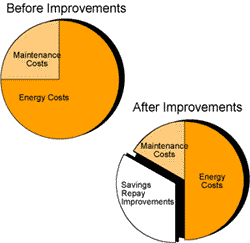An Energy Services Company (ESCO) is a commercial business that “will identify and evaluate energy saving opportunities and then recommend a package of improvements to be paid for through savings”.[1] Performance Contracting with an ESCO can be a very powerful tool for a company with energy saving opportunities but no upfront cash or financing options to implement the projects. An ESCO is a one-stop shop for energy opportunity identification, quantification, financing, implementation, staff training and a guarantee that the savings will cover the costs of the project. For a business, the bottom line is that one’s annual operating costs will not increase, because project financing and the cost of the ESCO are both covered in the energy and maintenance savings realized by the project. In addition, the ESCO assumes the risk of under-performance. If the savings are not achieved, the ESCO is responsible for covering the difference.
The ESCO Process
1. Initial Assessment
The process starts with a preliminary assessment by the ESCO to determine what energy saving opportunities reside in the building. Often opportunities are items such as boiler or chiller modifications, motor replacements, lighting retrofits, and the installation of a building control system. This initial assessment is performed at no cost to the owner.
2. Energy Savings Performance Contract
If both sides feel sufficient opportunities are identified in this initial assessment, the owner and ESCO begin with an Energy Savings Performance Contract.
 Energy Performance Contracting: Before and After Improvements. Source: Energy Sources Coalition - http://www.energyservicescoalition.org/resources/whatis.htm
Energy Performance Contracting: Before and After Improvements. Source: Energy Sources Coalition - http://www.energyservicescoalition.org/resources/whatis.htmThis contract initiates the comprehensive investment grade audit and details a variety of stipulations regarding construction, leases, performance guarantees, rate risks etc. The contract also states how savings will be determined: whether they are stipulated, in which case no field verification is required, or a more rigorous Measurement and Verification Protocol will be applied to verify savings over the course of the contract.
If the owner declines the implementation of the construction after this point in the process, the owner is liable for the audit costs (typically $50-$80k). If the owner proceeds, then the audit costs are rolled into the contract and the owner incurs no upfront costs.
A Performance Contract value is typically in the $1,000,000 range or up and lasts for 8-10 years, although some innovators are looking at how to apply the ESCO model on smaller projects with less savings potential. During the contract time period the energy savings are used to pay off the investment so the annual out-of-pocket costs for the owner do not increase.
3. Financing and Return on Investment
Project financing is typically arranged through a third party who is familiar with the ESCO and can value the savings guarantee appropriately. When financing costs are identified, a full contract delineating the efficiency measures, cost savings, construction costs, ESCO costs, financing costs and guaranteed savings is developed for a complete picture of the return on investment.
4. Construction and Staff Training
The ESCO is usually responsible for the entire construction process. In some cases, the contracts can allow for the owner to manage construction providing more transparency in the process. The owner’s involvement is typically to coordinate the work within their facility to minimize disruption to work flow and occupants. The ESCO uses commissioning to validate construction and provides training to ensure the maintenance staff understands how to operate new building systems. The owner then ensures proper maintenance of the equipment throughout the contract period.
5. Savings Verification and Annual Costs Reconciliation
The ESCO verifies savings that are not stipulated using meters and utility and maintenance billing analysis to verify the project’s overall savings. The return on investment calculations quantify the net operating cost gain or loss to the owner. The loan that funds the project is paid from the savings. In the event that the savings are not adequate to cover the loan payment, depending on the circumstances, the ESCO will pay the difference based on the savings guarantee. The ESCO typically receives a significant share of the savings in excess of the loan payment to cover their costs and help mitigate risk. If the project produces excess savings, we have seen owners reinvest in their building to allow for capital upgrades that may otherwise be unfeasible or accelerate the pay off of the project’s loan.
Advantages and Disadvantages of Performance Contracting
The most obvious advantage to working with an ESCO on a Performance Contract is that the owner does not have to take out a loan or invest any money upfront and that the return on investment is guaranteed. It is a very secure investment, with limited liability and financial risk. It produces a detailed assessment of the energy saving opportunities of the building, as well as providing a turn-key construction process that does not require the owner’s involvement.
The disadvantage of an ESCO’s involvement is that, in order to maximize profits, ESCOs often focus on lower cost measures with easy-to-predict savings and they often do not take a comprehensive approach which will provide deeper savings, but at a significantly higher cost. For example, lighting and mechanical system modifications will be suggested, but building envelope improvements (which typically have a very long payback period) will not be included. This is a lost opportunity in the sense that lighting measures with a 9-month payback can help reduce the envelope improvements’ 8 year payback when bundled together in one package. Another obvious disadvantage to using an ESCO is that it costs more money than if the owner would perform the project themselves. The ESCO’s overhead and profit are included in the project’s costs. If the owner hires an energy services company to perform the comprehensive energy audit and then implements the project alone (financing and construction), all of the savings will go directly to the owner.
Recommendation
All buildings have energy saving opportunities, even the newest buildings. In our experience the first major step is identifying and quantifying the magnitude of this potential. The most cost effective manner to commence reducing one’s energy consumption is to hire an energy services or commissioning company to perform an audit. (If using a commissioning provider, ensure they have expertise in energy efficiency and can identify opportunities for capital improvements that may exceed the retrocommissioning scope.) From there, an owner can decide the best direction to take. Retrocommissioning is a great vehicle to address energy efficiency and building system performance in order to provide optimal environmental comfort to building occupants. Typically, retrocommissioning is a less costly endeavor; having less than two year payback and does not involve major capital improvements. If energy saving capital improvements with long payback periods are identified, then an energy savings performance contract with an ESCO may be an appropriate avenue to accomplish these additional savings.
[1] http://www.energyservicescoalition.org/performance-contracting



